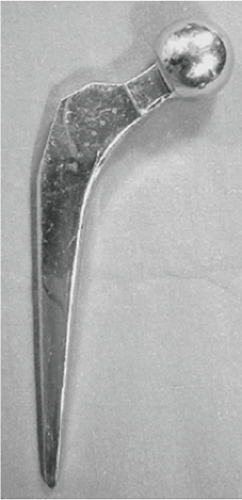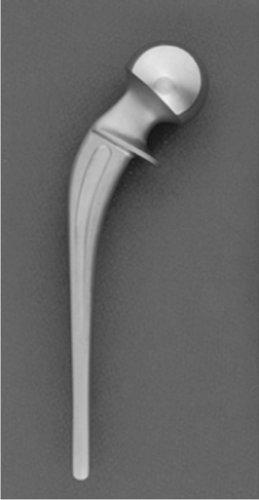Overview of Primary Femoral Components
John J. Callaghan
Steve S. Liu
Andrew J. Pugely
Total hip arthroplasty as we know it today has been performed in Europe starting in the early 1960s and in the United States in the late 1960s. Although there have probably been hundreds of designs developed by numerous companies since that time, successful femoral components can probably be categorized in a somewhat generic manner.
Cemented Femoral Components
The successful femoral components with track records for long-term durability can be categorized into two types. The design type that was designed and popularized in the United States in the late 1970s and early 1980s included a collar whose purpose was to load the proximal calcar. In addition, the stem geometry avoided sharp corners, especially on the medial aspect, to protect the cement mantle from fatigue. The metal utilized initially was stainless steel but because of fractures, chrome-cobalt became the material of choice. These components were initially matte finished (30 microinch Ra) and later were grit blasted. The finish returned to a matte finish when investigators found a higher loosening and osteolysis rate with the grit blasted designs. The first successful design that was evaluated long term was the HD-2 design by Howmedica (Fig. 55.1). Today in the United States, this type of design is still commonly utilized. In Europe, especially England, the success of a double taper polished stem (Exeter design) (Fig. 55.2) has become the cemented stem of choice with excellent long-term results. That design places all of the loads in compression which is user-friendly to the mechanics of cement and also minimizes osteolysis because of the polished surface. These are the two basic cement designs and concepts that are used today in cemented femoral replacement.
Cementless Femoral Components
Although cementless femoral fixation had been utilized by Lord and others beforehand, cementless fixation really came in to vogue in the early 1980s. Three basic design concepts have emerged. They include anatomic designs, straight stem designs, and tapered designs. In addition, there have been modular designs. The most successful have been designs that have a metaphyseal sleeve with a tapered stem. A more recent newer concept has been the double taper neck designs which have not performed well in general.
Anatomic Stem Designs
The rationale for an anatomic stem design was to design a component that matched the sagittal plane bow of the femur
(Figs. 55.3 and 55.4). The APR (Centerpulse, Austin, Texas) and the PCA (Howmedica, Rutherford, New Jersey) were the initial designs. Especially the PCA, with circumferential proximal coating, performed well and has been well studied. Although these designs provided excellent micromotion stability, they are not used in their present length today because they could not fit into all femurs. The design has been incorporated in some short stem designs which will be discussed at the end of this chapter.
(Figs. 55.3 and 55.4). The APR (Centerpulse, Austin, Texas) and the PCA (Howmedica, Rutherford, New Jersey) were the initial designs. Especially the PCA, with circumferential proximal coating, performed well and has been well studied. Although these designs provided excellent micromotion stability, they are not used in their present length today because they could not fit into all femurs. The design has been incorporated in some short stem designs which will be discussed at the end of this chapter.
 Figure 55.2. Polished tapered Exeter chrome-cobalt femoral component.
Stay updated, free articles. Join our Telegram channel
Full access? Get Clinical Tree
 Get Clinical Tree app for offline access
Get Clinical Tree app for offline access

|






